 |
||
|
||
| ||
By Maxim
Lyadov
Argument for a lazy reader
ABIT company who proved with their rather good motherboards some time ago has released a quite interesting sound card – the Home Theatre AU10. The card is based on the ForteMedia FM801 chip and AC'97 codecs. As the name indicates, the card is intended for creating a home theatre system based on the PC. The sample we have received has no digital connectors for external devices and it decodes the Dolby Digital 5.1 sound stream (a sound track of DVD movies) by any soft player on its six linear analog outputs. The card can be connected only with those computer speaker sets and receivers which have 5.1 analog inputs. The card is supplied with a soft DVD player WinDVD 2000, and a remote controller created specially for this program. The card has an emulation of support of main 3D sound standards in games, A3D 1.0 and EAX 1.0, by QSound algorithms on the drivers level. That's why for its comfort usage in hard games the computer should have a powerful CPU and sufficient size of RAM (I'd recommend not less than the PIII-500 and 128 MBytes RAM, 100 MHz FSB).
Sound PCI chip ForteMedia FM801
Now we will consider the "heart" of the ABIT AU10 sound card. This chip was developed by ForteMedia for desktop systems and notebooks. Let's turn to its structure chart: 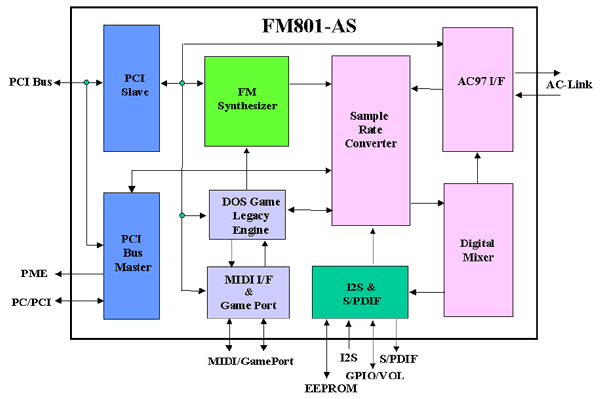
FM801 main features:
Complete set
The ABIT AU10 sound card, we have put our hands on, is something between retail and OEM variants. The package looks not very attractive (making a good package box for retail is in the ABIT roadmap now), it contrasts greatly with rich complete set inside:
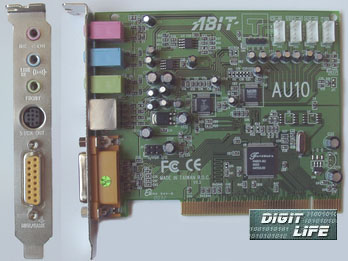


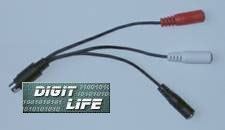

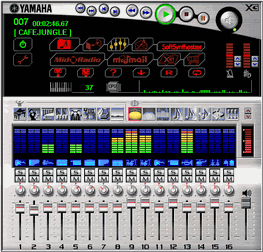
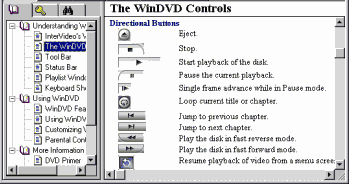
Installation
The drivers are supplied on a CD in 12 languages. The version at the time of testing was the same that was on the manufacturer's site. That's why the drivers were installed from the CD. The minimal requirements for the card installation (note that while following these requirements you can only playback MIDI (*.mid) and PCM (*.wav) files and play DOS-games):
The soft DVD player WinDVD2000 requires (source - WinDVD Requirements and Performance FAQ):
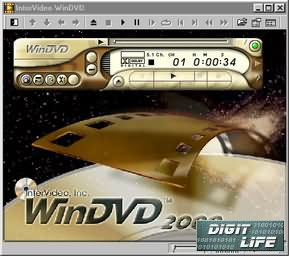 Test configuration:
Installation of the drivers to the ABIT AU10 was not difficult at all. Despite the fact that the drivers are of 1.0 version everything worked quite stable. After installation the following devices were added (they are in the red frame):

The card is equipped with a utility ForteMedia control panel, which allows choosing card's modes and set QSound effects in games and while listening to music.
Connection
The layout of the external and internal connectors: 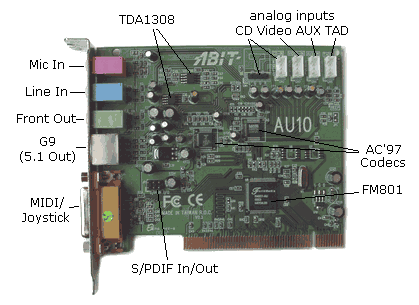 As you can see a distinguishing feature of the AU10 (like many other cards on the FM801 chip) is a special analog G9 connector requiring not very standard (for audio equipment) adapter "G9 -> 3 female minijack". The digital outputs are represented by an extension block. In the press releases of ABIT they mention an optical digital output that seems to be located on a separately connected daughter board. But the tested sample wasn't supplied with it. On the internal extension block I have found out digital input and output:  I marked in/out on photo (D stands for digital signal, G is ground). On some sound cards the digital input is intended for CD-ROM drive. On this card the digital S/PDIF input matters not much. The signal from the both drives failed to be identified due to its little amplitude (in my opinion): 0.5 V from the drive by the S/PDIF specification instead of 5 V of the TTL-level. Correspondingly, you can connect only another sound card which has an internal S/PDIF output. For example, SBLive! On the CT4830 model a signal can be taken from the S/PDIF#0 output (17 and 18 pin of the internal extension block), what I have implemented successfully: 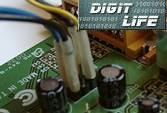 And the digital output can be applied to the external DAC or receiver, at your own risk. But if you are not sure in managing it, better do not do it. Otherwise, you may burn the card and the external receiver, since the output is not buffered (it goes right from FM801) and has a non-standard high level signal. What's all this for? It's simple. If there are several sound cards in the system, then you can connect the cards inside the computer digitally, and output the signal through analog outputs of only one card. Then you won't bother with manual switching on the exterior sound-reproducing part of audio track with variety of analog cables. I used unnecessary plugs (having shielded them in advance) from a 4-pin CD Audio connector as single connectors. This connector is usually used by me for 2-pin CD digital connector which is usually not supplied by manufacturers together with sound cards. What you need to do is to cut the both sides of the connector with a sharp knife, keeping the safety measures: 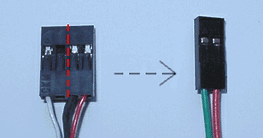 Changes in the SpectraLAB program
Below you can read the characteristics of the Home Theatre AU10 boards (with two-channel AC'97 codec SigmaTel STAC9721 and four-channel Wolfson XWM9704 codec) and my reference sound card SBLive! Value CT4830 (codec Creative CT1297-TAT and Philips UDA1330A – front and rear correspondingly). As usual, we used the SpectraLab 4.32.14 program for qualitative estimation of parameters of sounding. If you want to repeat the measurements I recommend to download the latest version of this program from www.soundtechnology.com There shown the spectrograms of the tests for harmonic distortions and noise when applying the reference 1 KHz sinusoidal signal to the input. The test sinusoidal signal with –3 dB amplitude was received in the wav-editor SoundForge 4.5 with a standard generator Simple Synthesis. For measuring characteristics received when the signal follows the external loopback we used a cable made of separately screened mic cables d=6 mm, 10 cm long. On the ends it has golden minijacks of a Taiwanese manufacturer. 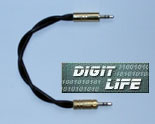
If you are not a specialists in the field of sound I recommend you to read my comments here (84 KBytes in RTF format).
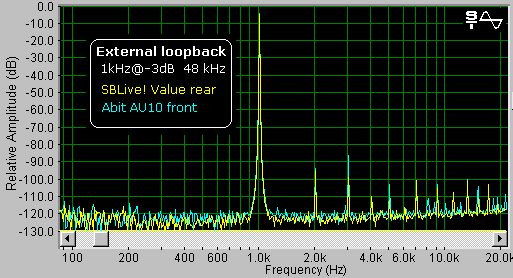
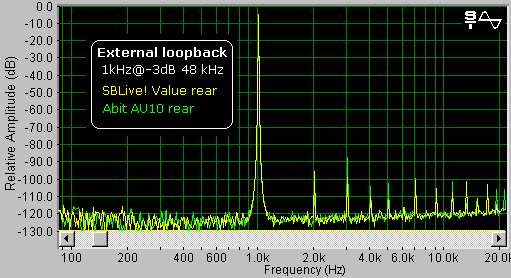
General comments. The ABIT AU10 card is inferior a bit to the SBLive! card in features. Looking closely at the spectrogram you can notice a higher level of 2, 3, 4, 5-th harmonics what resulted in more distortions. Noise floor is very similar of the both cards. I must admit that it was rather difficult for me to get this card work in normal mode. Usually, volume controls in the mixer of sound cards don't affect to much THD. Here, it's vice versa. With a definite volume value established in the mixer for Wave/DirectSound there is danger to get into the "red zone" and get a high distortion level. Terrible harmonics distortions start from only 70%! Look at the picture - the graph becomes nonlinear far before the clipping. 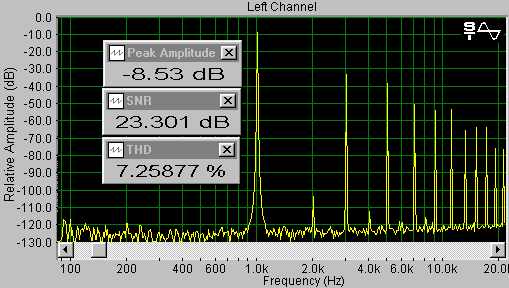 In order to avoid further troubles you should leave this volume control in the position which it took right after installation of drivers. And volume should be regulated via the Master Volume. The master volume control (which is located in the codec) works perfectly in any position.
FR tests revealed nothing strange. The FR of the card is uneven within +-0,5 dB what is rather acceptable. 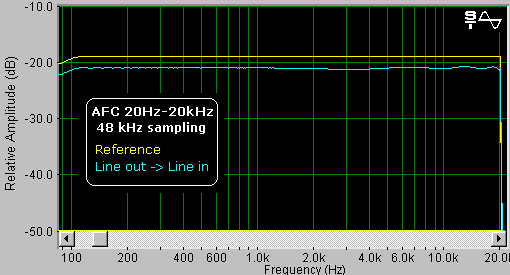
Impression gained from listening to music
I ran the CD-DA disc of "the CORRS", "Golden Collection 2000" album, (C) 2000 Lighthouse Records. It can be characterized as a light pop-rock with elements of Irish ethno. I played it with the TEAC CD-W54EK drive, the data were read via IDE bus through the plugin to WinAMP – the CD Reader. The music played through a home receiver Onkyo TX-DS484 (24bit/96kHz DAC, 5x75W PHC 6 Ohm, 5Hz-100kHz +0..-3dB) and speakers JPW ML510i (2x75 W RMS, 6 Ohm, 89 dB/W on 1m, 60-22000 Hz +-3dB). The signal was taken from digital and analog outputs of the Live! and AU10. The comparison was carried out with switching from digital to analog mode and back, using the remote controller of the receiver, without breaking the composition. When in digital mode the both cards sounded equally perfect. When in analog mode, the difference from the digital mode of the Live! was rather small, and the ABIT AU10 showed rather bad sound quality. To my mind the sound was a bit "flat", the timbres of different instruments were a bit dim.
Sound track playback in DVD movies
For testing quality of DVD track reproduction (in movies) we used the same home theater set as in the previous reviews: Onkyo TX-DS484 + 5.1 set of "non-computer" acoustics (the guiding price is ~$1600). For connecting the sound card to the test receiver I used 3 cables "stereo minijack -> two connectors" that are not included in the package. The red jack was connected to the audio inputs for front speakers, the white one – for rear speakers, and the black one – for central speakers and a subwoofer. Sounding from 6 analog outputs greatly yields to that which we have received from the digital output. The tested Live!5.1 with the same system left more pleasant impression. But when replaced the acoustics for the worse (wooden Radiotechnika S30B of the same capacity in litres), the difference was not so noticeable, and it's not surprising. When using plastics sets up to $100 everything won't be so bad since the acoustics will become a major bottleneck determining the sounding quality. Games
People often dispute in multimedia conferences about how different cards sound in games. They have only one card at that, and create an opinion on other cards listening to other readers. This situation should be immediately corrected. Unfortunately, we can't test all sound cards on all versions of their drivers in all game programs. But considering your high interest to this issue we will pay now more attention. For the tests I chose a game American McGee's Alice created on the Q3 engine. I have chosen this game due to support of "the coolest" interfaces in it: A3D 1.0/2.0 and EAX 1.0/2.0. Exactly for checking sound quality claimed for AU10 interfaces A3D 1.0 and EAX 1.0, with Qsound algorithms, we installed the SBLive! and Aureal SQ Digital cards as the reference ones, for which these API are native. In my opinion, fps measurement for sound cards has no practical sense, since the sound quality matters much more for creating realistic and fascinating atmosphere then some hardly noticeable losses in speed and fluency of a game. Besides, speed is more important in dynamic games, while in strategies and quests it's not a critical value. That's why I decided not to measure speed in demo-tests. Now are coming my impressions of all three cards in this game. The sound was compared both in digital and in analog modes. The total results don't change with it. It means that it is a sound chip and drivers of each certain card to blaim for downsides.
The ABIT AU10 card in the sounding yields to the Live! in this game. But at the same time it sounds a bit better than the Vortex2. But the similar price for all three sound cards doesn't let us give an allowance to any card. All these differences were heard with rather good audio equipment. With quality decreasing of the analog part of the sound-reproducing system the differences will be minimal. This of course doesn't concern vivid distortions in sounding such as sound "drop out" on the Vortex2. The worst defect of the sound of the ABIT AU10 in this game concludes in wheezes at high frequencies. Localization of the sound source in this game is not so good. Realization of the A3D technology here is not impressive either. The second test game was "Soldier of Fortune". The developers of this game are veterans from Raven Software (known for the Heretic 1/2 and Hexen 1/2). This game supports only base variants of sound interfaces, i.e. only A3D 1.0 and EAX 1.0. At the same time, the quality of the samples is not high. The max sampling is only 22 KHz! And I suspect that the samples are 8-bit in original which are decoded in 16 bit. The Live! could work with EAX, the Vortex2 - with A3D, and the AU10 refused working with either standard. That's why we chose "pseudo EAX" mode for it. It means that in the Control Panel Reverberation mode was set: The ABIT AU10 sounded a bit better than the Aureal SQ Digital. The main claims to the sound in A3D mode are mixed up channels and too quiet sounds. And all this happened despite the downloaded official EAX and A3D patches. The SBLive! sound card in this game, like in the previous one, took the absolute lead. All required sounds were reproduced, and what matters most of all – at the expected volume level. Positioning in the DirectSound3D was very good. In order not to be unfounded and to avoid all accusations of subjectivity I will give you a record of sound accompaniment of the initial caption in the first mission of the Soldier of Fortune for all three cards. If you are now deciding which card should be bought I advise to listen these files on your acoustic system. If you do not hear any noticeable differences, then buy any card you like.
Conclusion
The ABIT Home Theatre AU10 is rather a budget solution for not the weakest PC. The main advantage is its price. 6 analog outputs and a remote control – such a combo can be found only on the Platinum 5.1 at 4 times higher price. The AU10 will suit not very exacting user which plans: listen to music in MP3 format, sing karaoke with the soft-synthesizer S-YXG50, playback DVD movies with the supplied WinDVD player controlled with the remote control. In general, it's rather good variant for a home computer system. Anyway, it's for you to make a choice. Write a comment below. No registration needed!
|
Platform · Video · Multimedia · Mobile · Other || About us & Privacy policy · Twitter · Facebook Copyright © Byrds Research & Publishing, Ltd., 1997–2011. All rights reserved. |